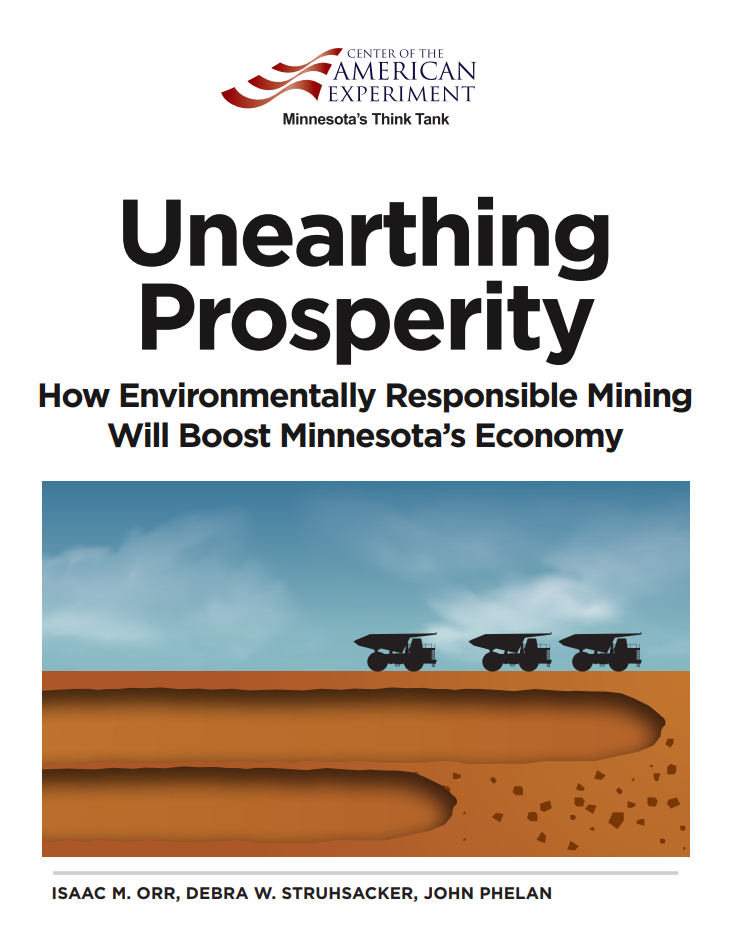Unearthing Prosperity: How Environmentally Responsible Mining Will Boost Minnesota’s Economy
Executive Summary
Minnesota’s unique geology makes the state a treasure trove of mineral resources. In 2017, Minnesota mined $3.18 billion in metals and minerals primarily iron ore, sand and gravel, and dimension stone, making the state the sixth-largest producer of non-fuel minerals in the United States. However, Minnesota’s mining industry could be much larger.
In fact, it could be a powerful force for the economy of the entire state. This report evaluates the mining potential of Minnesota and reaches twelve main findings that buttress one conclusion: Minnesota can reap the tremendous economic benefits of mining its mineral resources and enjoy a safe and clean environment at the same time.
Daily life requires mining: The Minerals Education Coalition (MEC) reports that every American born in 2017 will require an average of 3.188 million pounds of minerals, metals, and fuels in his or her lifetime. For example, the average house built in the United States contains 400 pounds of copper, and the average car contains approximately 50 pounds of copper.
Minnesota is well positioned to help meet America’s demand for metals.
Minnesota’s mineral deposits are massive: Northern Minnesota is home to one of the largest undeveloped deposits of copper, nickel, and platinum group elements in the world.4 Minnesota also has the largest deposits of ilmenite, the most important ore for titanium, in North America.
The economic benefits of mining these resources would be tremendous: Developing these resources would add approximately $3.7 billion to Minnesota’s annual economic output, support more than 1,900 direct jobs and 6,566 indirect and induced jobs, with total wages of $635 million, and generate nearly $198 million in tax dollars for state and local governments.
These estimates are very conservative: Our calculations are based only on publicly-available data from mining projects in the permitting or preliminary planning stages, but several of Minnesota’s copper- nickel deposits—including the Mesaba, which is the largest copper-nickel deposit in the state—do not have public resource calculation estimates available at this time.
As a result, our numbers are a floor, not a ceiling.
Minnesota would have been the number-three state: In terms of non-fuel mineral production, Minnesota would have ranked third if it had mined these resources in 2017. Minnesota has not ranked third since 2012, and it has been falling in the rankings ever since.
In total: Minnesota’s metals and minerals are worth more than $187 billion at current prices, if they are
developed.
Minnesota schools will especially benefit from more mining: Because much of the non-ferrous mining will be done on land held by the Minnesota Permanent School Trust Fund, schools all over
Minnesota will receive additional revenue in addition to the $198 million in tax revenue generated for state and local governments.
Modern mining is safe for the environment: Mining critics argue that developing Minnesota’s mineral wealth will endanger the environment, but strict environmental protections and advances in mining and environmental protection technologies have vastly reduced the environmental impact of modern mines. Mining and a healthy environment can, and do, coexist.
No mines permitted since 1990 by either the Bureau of Land Management (BLM) or the U.S. Forest Service have been added to the National Priorities List (NPL), a prerequisite to becoming a Superfund site: BLM has approved 659 mining plans since 1990, and the Forest Service has approved 2,685 plans since 1990 with no sites being placed on the NPL.
The Flambeau Mine and the Eagle Mine show mining can be done safely in the Midwest: Two modern mines in neighboring states, the Flambeau copper-gold-silver mine in Wisconsin and the Eagle nickel-copper mine in Michigan, show how today’s mines are safe for the environment and good for local communities. Modern environmental protection measures, including liners, covers, and water treatment systems, were used at the Flambeau Mine and are being used at the Eagle Mine to effectively manage acid mine drainage and protect the environment.
If these minerals are not mined in Minnesota, they will be mined somewhere else: Despite the fact that the United States is one of the largest consumers of metals and minerals in the world, Americans are heavily dependent upon imported resources to meet their mineral needs.
Oftentimes, this means mining occurs in countries with poor protections for mine workers and the environment: For example, 55 percent of the world’s cobalt is produced in the Democratic Republic of the Congo (DRC), where the United Nations International Children’s Emergency Fund (UNICEF) estimates as many as 40,000 young boys and girls are working in cobalt mines.
Our state can benefit economically from developing these resources and protect the environment at the same time.
